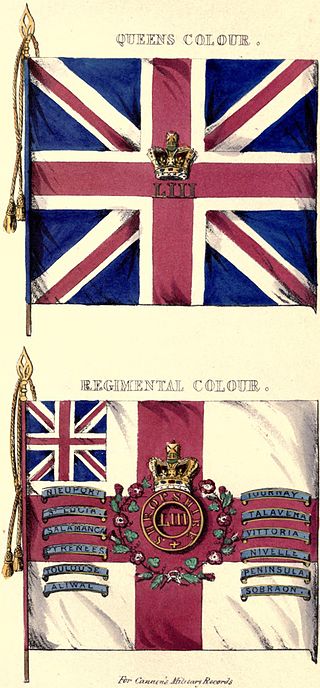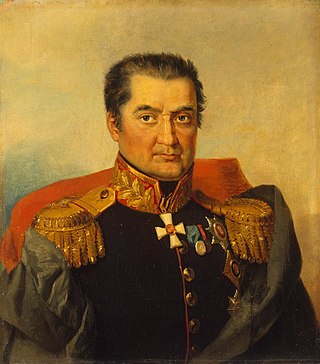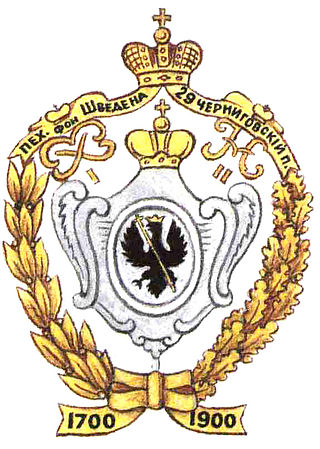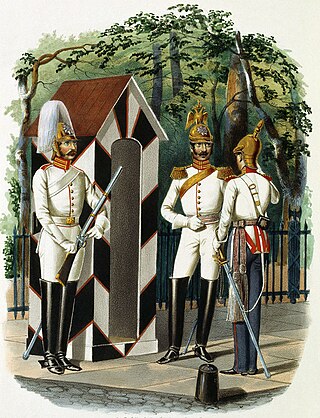
The House of Tolstoy, or Tolstoi, is a family of Russian gentry that acceded to the high aristocracy of the Russian Empire. The name Tolstoy is itself derived from the Russian adjective "толстый". They are the descendants of Andrey Kharitonovich Tolstoy, who moved from Chernigov to Moscow and served under Vasily II of Moscow in the 15th century. The "wild Tolstoys", as they were known in the high society of Imperial Russia, have left a lasting legacy in Russian politics, military history, literature, and fine arts.

The House of Wrangel is a Baltic German noble family, whose members have also been included in Swedish, Russian, Spanish and Prussian nobility. The family's earliest known patrilineal ancestor is the knight Eilardus (1241†).

Yefim Ignatyevich Chaplits/Tschaplitz, born Eufemiusz Czaplic, was a Polish military commander in the service of the Russian Empire.

The 53rd (Shropshire) Regiment of Foot was a British Army regiment, raised in 1755. Under the Childers Reforms it amalgamated with the 85th Regiment of Foot to form the King's Shropshire Light Infantry in 1881.

Novgorod Governorate was an administrative-territorial unit (guberniya) of the Russian Empire and the Russian SFSR, which existed from 1727 to 1776 and from 1796 to 1927. Its administrative center was in the city of Novgorod. The governorate was located in the northwest of the European part of the Russian Empire.
Nikolay Ivanovich Demidov was a Russian General of Infantry, Adjutant-General and senator.

Count Peter Essen was a Baltic German General of the Infantry in 1819 and a count (1833). He belongs to the bourgeois Essen family from Pärnu. Essen's only daughter, Alexandrine Essen (1816–1868), married count Pontus von Stenbock-Fermor (1806–1866) in 1835, at which point they began using the joint name Essen-Stenbock-Fermor.

His Majesty Lifeguard Jaeger Regiment, short also Lifeguard Jaeger Regiment, was a Jäger regiment of the Russian Imperial Guard from 1796 to 1917.

Arkhangelsk Governorate was an administrative-territorial unit (guberniya) of the Russian Empire and the Russian SFSR, which existed from 1796 until 1929. Its seat was in Arkhangelsk. The governorate was located in the north of the Russian Empire and bordered Tobolsk Governorate in the east, Vologda Governorate in the south, Olonets Governorate in the southwest, Sweden in the west, and Norway in north-west. In the north, the governorate was limited by the White and Barents Seas.
Ivan Fyodorovich Emme was a Russian lieutenant general in the Napoleonic Wars.

Yevgeni Ivanovich Markov, was a Russian infantry commander during the French Revolutionary Wars and the Napoleonic Wars.
The Militia and Volunteers of County Durham are those military units raised in the County independent of the regular Army. The "modern" militia dates from legislation enacted during the Seven Years' War. The volunteers had several forms and separate periods of existence until made a permanent body in 1859.
The 27th Infantry Division was an infantry formation of the Russian Imperial Army. It was a part of the 3rd Army Corps.
The 2nd Grenadier Division was an infantry unit in the Imperial Russian Army as part of the Grenadier Corps. Its headquarters was located at Moscow. Notable engagements of the division include the French invasion of Russia.

The 29th Chernigov Infantry Regiment was an infantry regiment of the Russian Imperial Army.

The 2nd Pavlograd Life Hussar Regiment was a cavalry regiment of the Imperial Russian Army.

The Life Guard Horse Regiment was a cavalry regiment of the Imperial guard of Russian Empire. The regiment was founded in the reign of Peter the Great and was disbanded after the October Revolution in 1917. Its annual feast day was 25 March.

Prince Peter Ivanovich Shalikov was a Russian sentimentalist writer, journalist and publisher.

Pavel Nikolayevich Ushakov — Russian commander of the era of the Napoleonic Wars, general from the infantry of the Imperial Russian Army, adjutant general.

The 51st Lithuanian Infantry Regiment, known as the 51st Lithuanian Infantry Regiment of His Imperial Highness Heir to the Tsarevich from 1904, was an infantry regiment that served in the Imperial Russian Army.
















